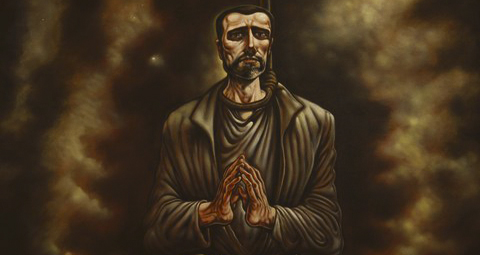September 14 | ![]() 1 COMMENT
1 COMMENT ![]() print
print

Monument to a martyr reminds us to fight for our religious freedoms
By David Kerr
In three years’ time we’ll mark the 400th anniversary of the martyrdom of St John Ogilvie. The Presbyterian convert turned Catholic priest was executed by the Episcopalian Archbishop John Spottiswoode on Tuesday, March 10, 1615. Fr Ogilvie was only 36 years old.
Captured, imprisoned, tortured and hanged before a baying public at Glasgow Cross the Jesuit priest’s sole crime was his inability to betray his Christian conscience before the bullying power of the central state as manifested in the person of King James VI.
“In all that concerns the king I will be slavishly obedient,” Fr Ogilvie told his accusers. “If any attack his temporal power, I will shed my last drop of blood for him. But in the things of spiritual jurisdiction which a king unjustly seizes I cannot and must not obey.”
As it happens, the cause of religious liberty was supported by both Calvinist and Catholic Scots ever since King James, resident in London after 1603, had dismissed Presbyterianism as ‘no religion for a gentleman’ and attempted to impose his caesaropapist Anglican settlement upon the Scottish people.
On October 17, 1976, Pope Paul VI declared Fr John Ogilvie to be Scotland’s first Canonised saint since St Margaret, Queen of Scots, in 1250 and St William of Perth in 1256.
Since then, infrequent artistic attempts have been made to mark the life and death of Scotland’s only post-Reformation saint.
The latest and most ambitious emerged in November 2010 when painter Peter Howson unveiled his eight-foot high canvas depicting the moment of St John Ogilvie’s martyrdom. Two years in the making, it is now stationed above a side altar in the newly refurbished St Andrew’s Cathedral in Glasgow.
Last month, though, the portrait was dismissed in an opinion article in the socially liberal newspaper of record, The Guardian, as but another shiny ‘trinket’ in a ‘gaudy cathedral’ that was a ‘monument to vanity.’ I beg to differ.
Firstly, try to take the time to sit before the Howson painting. Do it. Look. Ponder. Pray. What do we observe? I would suggest the following;
With a terror-stricken countenance and tear-filled eyes, Fr Ogilvie feels the noose tighten around his neck. The moment of execution is imminent. Surrounding him is an ever-enveloping darkness. Only one solitary light manages to pierce the heavy gloom. It is the moon-like luminance of the Eucharist, breaking through his dark night of fear and loneliness.
Unlike many artistic depictions of the martyrs this is no steely-tempered superhero. The saints and the martyrs, however, were not stoics and their ability to bear martyrdom was not borne from stoicism. It was borne from love.
The source and object of Fr Ogilvie’s love is the divine person of Jesus Christ who is truly present—body, blood, soul and divinity—in the Eucharist.
“If you follow the will of God, you know that in spite of all the terrible things that happen to you, you will never lose a final refuge,” Pope Benedict XVI wrote in his biography of Jesus of Nazareth.
“You know that the foundation of the world is love, so that even when no human being can or will help you, you may go on, trusting in the One who loves you.”
Finally, in the gothic-arched panel above the main canvas we witness the heavenly culmination of this loving relationship of creator for creature. Atop everything is the guiding beacon of the Eucharistic chalice and host as countless ranks of souls are shepherded safely home beneath the monogram ‘IHS,’ the emblem of St John Ogilvie’s order and the first three letters of the Holy Name of Jesus in Greek.
As it was in 17th century Great Britain, so it is now in 21st century United Kingdom. In 2007 there were 16 Catholic adoption agencies operating across the UK. They believed that children generally do best when they have a mum and dad who are married. The sociological evidence of the past 40 years supported that policy. Suddenly, though, the law of the land did not.
Since then 14 of our adoption agencies have been closed down by the state or forced to recant their Catholicism to remain in operation. The two Catholic agencies that survive are still fighting for their lives.
Now eminent human rights lawyer Aidan O’Neill QC is warning that the impending redefinition of marriage will likely see Catholics further persecuted for trying to uphold or promote that vision of the family based on a married mother and father. Catholic parents, children, priests, teachers and charity workers, he predicted, could all face the sinister squeeze of an increasingly intolerant state.
How long before our dioceses or welfare projects are threatened with the loss of charitable status? Or our secondary schools are accused of ‘peddling tax-subsidized bigotry?’ Will the slogan be ‘no hate on the rates’ or ‘no poll-tax for prejudice?’ Stay tuned. I’m sure we’ll all find out soon enough.
This month, David Cameron’s government outlined its definition of ‘freedom of religion’ to the European Court of Human Rights. Faced with a challenge from four English Christians who allege that they lost their jobs due to their religious beliefs, the UK Government not only rejected the claims but also, ominously, stated the following: “The applicants are free to resign if they consider that the requirements of the employment are incompatible with their religious beliefs,” Paragraph 13 of the official UK submission said. “It is the ability to resign and seek employment elsewhere that guarantees freedom of religion.”
If you didn’t laugh, you’d cry. The noose is once again tightening.
After his execution, Fr John Ogilvie corpse was condemned to a pauper’s grave in Glasgow’s Townhead. Archbishop Spottiswoode, who later became Lord Chancellor of Scotland, was buried at Westminster Abbey amid all the pomp the state could muster for him.
Heard lately of anybody commissioning a painting in honour of Spottiswoode though? Exactly. St John Ogilvie, pray for us.












Spot on, David – good to see you’re still keeping the flame alight.
God bless,
Geoff Callister (ex NN and the new DG!)